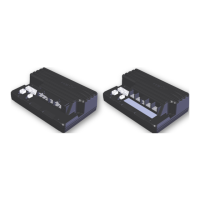GBK51948 RHINO2
Installation Manual Issue 5
Figure 24: Neutral detect function
* The Neutral Detect switch can be connected to B+ or B-, dependent on which option is selected in the Active
field of the Pin [x] Function parameter. For more information, see 6.5.9.2 Active States and 8.1 Neutral Detect
Active States.
To use this option, set the Throttle Input parameter to 'Single' and select the correct
throttle type with the Throttle Type parameter. Connect the Neutral Detect switch to one of
the Multifunction Inputs, and set the corresponding Pin [x] Function parameter to 'Neutral
Detect'.
This option can be used with a speed limit pot in series as well as with a speed limit pot in
parallel. See 5.9.6 Speed Limit Pot Connections for details.
Note
The Neutral Detect function assumes that the throttle is in Neutral when the Neutral Detect input is in its active
state.
For optimal mechanical accuracy, the neutral window of the Neutral Detect switch (the range of physical
throttle deflection at which the switch indicates 'Neutral') should be as narrow as possible.
Make sure that the Throttle Dead-band parameter is set larger than the mechanical neutral window of the
Neutral Detect switch, otherwise throttle faults will occur.
If the throttle potentiometer is powered externally (not by T+ and T-), take care to avoid ground shift. Ground
shift will result in a throttle fault.
Make sure that any mechanical design has the same lifespan as the throttle potentiometer.
5.9.3.1 Installation of a Neutral Detect switch
To detect the physical neutral position of the throttle potentiometer, many options are
possible. Two options are shown here.
Disk with micro-switch
Mount a disk to the potentiometer shaft. The disk must have a notch, in which the roller of a
micro-switch will fall when the throttle is in the neutral position. Fasten the disk in the
correct neutral position with a screw.
Page 38 - Installation and testing

